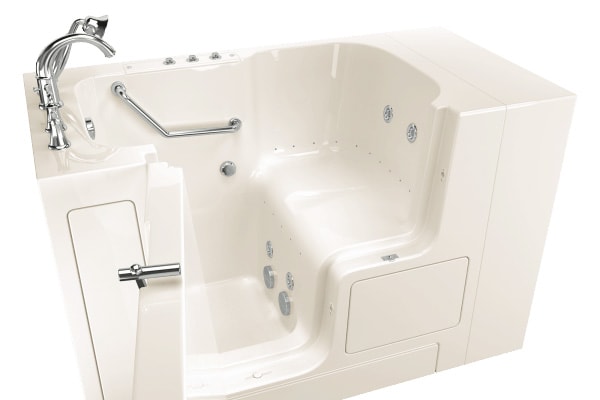How to Get Financial Assistance for a Walk-in Tub

For seniors, falls are among the most deadly injuries you can sustain. According to the CDC, they account for over 3 million injury-related emergency room visits every year for people age 65 and older. In addition, 80 percent of falls sustained in the home happen in the bathroom.
These statistics highlight the importance of stability in the bathroom to prevent injury. Walk-in tubs allow seniors to circumvent the risky process of getting into and out of their tubs, which is a major culprit of fall injuries. Unfortunately, walk-in tubs can cost anywhere from $2,000 to $6,000 for a basic safety model, not including installation costs, which vary widely depending on the capacity of your water heater and bathroom setup.
While Medicare won’t cover the cost of a walk-in tub, there are a variety of other programs that can help pay for a large portion of their costs.
Pro Tip: To learn more about walk-in tubs, check out our guide to this year’s best walk-in tub manufacturers.
Our Top-Rated Walk-In Tub Manufacturers
If you’re looking for financial assistance to purchase a walk-in tub, it’s helpful to know that no single model is perfect for everyone, but we’ve found three brands that consistently offer the best overall value. These brands feature a variety of models designed to fit different bathroom spaces, ensuring you can find an option that meets your needs and budget.
USDA Rural Repair and Rehabilitation Program
The USDA Rural Repair and Rehabilitation program, also known as a Single Family Housing Repair Loan, helps low-income homeowners upgrade their homes. It contains a provision for senior homeowners who hope to make their homes safer, so a walk-in tub may qualify.
Assistance comes in the form of a 20-year loan at a maximum of $40,000 or a grant of $10,000 to eligible seniors. Eligibility is determined by income, marital status, and the state of your home.
Apply here to see if you’re eligible.
Housing Improvement Program
The Housing Improvement Program (HIP) is offered by the Bureau of Indian Affairs to assist members of American Indian or Alaskan Native tribes with home repairs. Eligible homeowners must have an income of less than 150 percent of the DHHS poverty guideline, which differs depending on the number of people who live in the house, starting at $14,580 for one person.
Contact the U.S. Department of Housing and Urban Development to see if you are eligible for aid from the HIP. The assistance offered can be as much as $7,500 for safety-related home repairs and up to $60,000 for building code-related renovations.
Older Adult Homes Modification Programs
Older Adult Homes Modification Programs are offered by the Office of Healthy Homes. Its purpose is to organize programs with local and state authorities to help seniors modify, repair, or improve their homes for safety.
Typically, their modifications include ramps, transfer benches, railings, and nonslip flooring. However, eligible low-income seniors (age 62 and older) can apply for funding for other additions like a walk-in tub. The organization has been funded with $15 million to assist low-income homeowners with safety modifications.
Visit the U.S. Housing and Urban Development website to view the application for the grant program.
State-Based Programs
State-based programs are worth looking into to see if you can get unique grants from your state to cover part or all of the cost of a walk-in tub.
For example, the Maine Home Accessibility and Repair Program covers homeowners with an income below or equal to 80 percent of the AMI Income Limit for structural repairs, heating/electrical updates, and more. The Home Accessibility Program in Illinois offers eligible seniors up to $25,000 for accessibility and safety modifications.
Contact your state’s unique aid program to learn about your eligibility for a safety modifications grant.
Safe at Home Program
The Safe at Home program is offered by Rebuilding Together, which offers its services through numerous local affiliates. Visit its services locator to see if there is a local affiliate near you.
Safe at Home offers help in installing fall prevention modifications around the house. This includes grab bars, wider doorways, raised toilets, and a modified tub and shower.
Contact the affiliate nearest to you to learn about your eligibility and how much you can potentially receive to install a walk-in tub.
Habitat for Humanity
The well-known housing charity Habitat for Humanity has a program known as Aging in Place, which helps seniors with home modifications and repairs. Its aid model includes a home repair assessment, human services assessment, and continued community services from the organization’s volunteers, including home cleaning.
They could potentially help you pay for or install a walk-in tub, depending on your eligibility. To get started, find your local Habitat for Humanity representative through its services locator to see if you can schedule an assessment.
Veterans’ Programs
Veteran Directed Care
Veteran Directed Care is offered by the U.S. Department of Veterans Affairs. It provides personal care services, including bathing and meals for senior veterans, that are paid for through a budget managed by the veteran or their caretaker. This could include putting money toward a walk-in tub.
Available services and eligibility criteria differ by state, so visit the Veterans Affairs website to learn if you may be able to use its services to pay for a walk-in tub.
VA Aid and Attendance Benefits
The VA Aid and Attendance Benefits, or Housebound Allowance, is offered through local VA branches through pension management centers. The application form must include a statement of need as well as a doctor’s report. You can also apply in person at your regional VA office.
Your eligibility depends on having a VA pension and spending the majority of your time at home due to a disability. You can’t receive both benefits simultaneously, but you can apply for either. Contact your local VA office or visit the VA website to fill out the application.
Home Improvement and Structural Alterations Program
Another service offered by the U.S. Department of Veterans Affairs, the Home Improvement and Structural Alterations program is part of its Rehabilitation and Prosthetic Services. It will not cover what it calls “Jacuzzi-type tubs,” so you will need to demonstrate that a walk-in tub addresses a safety concern caused by a service-connected disability.
You can be approved for $6,800 for home improvements related to a service-connected disability or $2,000 for other disabilities. You can view its application process here.
Bottom Line
Walk-in tubs could be a significant improvement to the safety of your home. They can prevent dangerous falls, which become more life-threatening as you get older. Unfortunately, walk-in tubs can be expensive, which is why the above aid programs could be a lifesaver.
The help that’s out there generally comes from charity organizations, state funds, retirement/pension organizations, and veterans’ affairs offices. Use the above information to contact the local affiliate of the organization whose requirements sound closest to your situation to find out your eligibility for funding for your walk-in tub.
To learn more about safely aging in place, read our guide to home modifications that help prevent falls.








